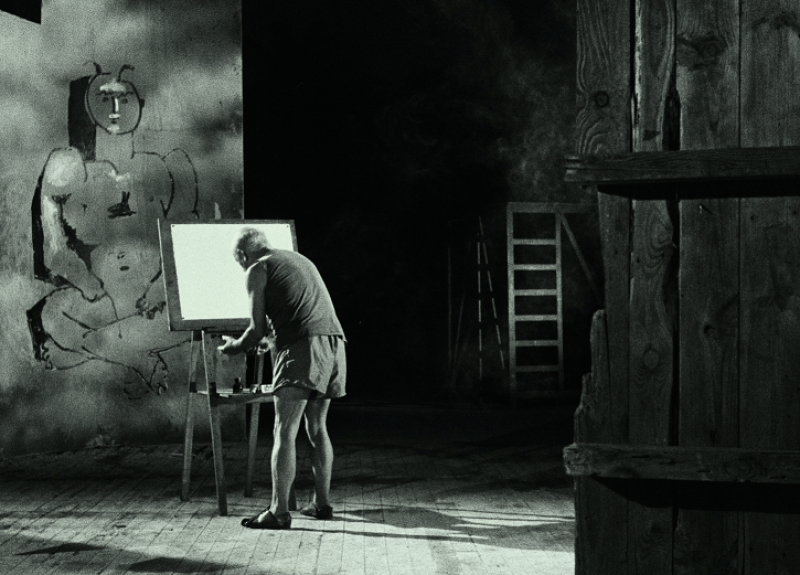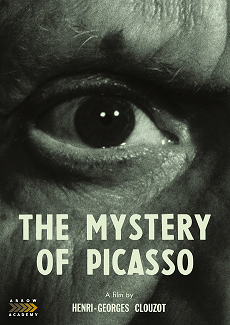DVD/Blu-ray: The Mystery of Picasso | reviews, news & interviews
DVD/Blu-ray: The Mystery of Picasso
DVD/Blu-ray: The Mystery of Picasso
Pablo at work: Henri-Georges Clouzot’s 1956 art documentary, with wonderful extras

What a gallimaufry! The polymath Picasso (1881-1973) was one of the most prolific, obsessed and best-known artists in the history; in fact, without qualification, he remains the best-known, for his genius, his mastery of so many media, his public personal life.
The Mystery of Picasso, remastered for this Arrow Academy release, is Henri-Georges Clouzot’s 1956 film of Picasso drawing (Clouzot, better known for his thrillers like Les Diaboliques, made it with cameraman Claude Renoir, grandson of the artist). It was filmed over a month in the south of France, using transparent canvases to show the drawing or painting materialising before our eyes. (The premise was that we, the audience, in such a way would have been privileged to see Mozart composing his Jupiter symphony, or Rimbaud his poem Le Bateau ivre.) Nearly two hours of material show lines materialising on paper, followed by colour, then revisions, erasures and, for the longest time, the final drawing/painting; then almost total erasure again, and Picasso telling us it just did not work, and starting over, and over again.
 At least 20 artworks were created with a kind of ferocious fluency. Picasso was in shorts and sandals, bare-chested, and really enjoying himself; he smoked continuously and obviously thought the whole thing a jolly jape, but he was seriously invested in the drawing/painting. The most spectacular was a fantastical fish that turned into a chicken and then, overwhelmed with colour, into something else, ambiguously appealing. Faces appeared from nowhere; he liked older men and naked young women, especially their breasts and bottoms, scenes in the artist’s studio, and moments by the seaside.
At least 20 artworks were created with a kind of ferocious fluency. Picasso was in shorts and sandals, bare-chested, and really enjoying himself; he smoked continuously and obviously thought the whole thing a jolly jape, but he was seriously invested in the drawing/painting. The most spectacular was a fantastical fish that turned into a chicken and then, overwhelmed with colour, into something else, ambiguously appealing. Faces appeared from nowhere; he liked older men and naked young women, especially their breasts and bottoms, scenes in the artist’s studio, and moments by the seaside.
None of the art – while obviously Picassos: we saw him doing them, and the last image was his flourish of a signature – was obviously much good by his standards. But it was fun for him, and some serious points were made; by his own admission, he started with a line and just saw where it took him; he had no preconceived ideas and held no finished composition in his head. It was the journey that was transfixing. But at almost two hours it all went on a bit too long – the fault of Clouzot, the film’s mastermind; having captured the maestro, he was reluctant to let him go.
But this release is worth it, and more, for the extras. First, in wobbly black and white and with BBC received pronunciation, is Paul Haesaerts’s 1949 A Visit to Picasso, finding him in Vallauris, where both art and the artist were installed in a collection of historic buildings. This is a period piece, amazingly awkward and pompous by today’s standards. But it paradoxically proves a neat crash course in Picasso’s styles, showing 10 different ways in which he portrayed a woman’s face, and 10 different ways he portrayed another motif, the bull. Next, in scratchy colour, La Garoupe, an amazing 1937 home movie by Man Ray, on a giggly holiday near Antibes with Picasso, Paul Eluard and other friends, as well as assorted wives and mistresses, gorgeously lip-sticked and casually glammed up in sundresses. Surrealist play ensued with great palm leaves as facial masks.
Picasso had the ability not to become downhearted: his joy does come through
But the pièce de résistance is a brilliant interview with Maya, Picasso’s daughter by Marie-Thérèse Walter, in age, remembering the making of the Clouzot film: she had helped on it, in her twenties. In fact, in one scene her nylon bra was borrowed as a surface on which to draw: the technical problems were enormous and in that sense, too, the 1956 film was pioneering.
Picasso, always up for it, wanted Maya to sleep with Claude Renoir, on the grounds that the mating of a Renoir and a Picasso would produce a world-beating artist, she recalls. Shock horror: she thought Claude so kind, but he was 42! Ancient! She obviously thought her father a wonderman but was also clear-sighted; he was careful with money, hating to spend it so that he would always have a lot in his pocket just in case, and Picasso and Maya during the time of the filming had only three sweaters between them. Picasso, she told us, had the ability not to become downhearted: his joy does come through in the film. As does hers now, a daughter enmeshed in familial complexities, but also a collaborator. These are period pieces well worth watching.
rating
Share this article
The future of Arts Journalism
You can stop theartsdesk.com closing!
We urgently need financing to survive. Our fundraising drive has thus far raised £49,000 but we need to reach £100,000 or we will be forced to close. Please contribute here: https://gofund.me/c3f6033d
And if you can forward this information to anyone who might assist, we’d be grateful.

Subscribe to theartsdesk.com
Thank you for continuing to read our work on theartsdesk.com. For unlimited access to every article in its entirety, including our archive of more than 15,000 pieces, we're asking for £5 per month or £40 per year. We feel it's a very good deal, and hope you do too.
To take a subscription now simply click here.
And if you're looking for that extra gift for a friend or family member, why not treat them to a theartsdesk.com gift subscription?
more Film
 Urchin review - superb homeless drama
Frank Dillane gives a star-making turn in Harris Dickinson’s impressive directorial debut
Urchin review - superb homeless drama
Frank Dillane gives a star-making turn in Harris Dickinson’s impressive directorial debut
 Mr Blake at Your Service review - John Malkovich in unlikely role as an English butler
Weird comedy directed by novelist Gilles Legardinier
Mr Blake at Your Service review - John Malkovich in unlikely role as an English butler
Weird comedy directed by novelist Gilles Legardinier
 Don't Let's Go to the Dogs Tonight review - vivid adaptation of a memoir about a Rhodesian childhood
Embeth Davidtz delivers an impressive directing debut and an exceptional child star
Don't Let's Go to the Dogs Tonight review - vivid adaptation of a memoir about a Rhodesian childhood
Embeth Davidtz delivers an impressive directing debut and an exceptional child star
 One Battle After Another review - Paul Thomas Anderson satirises America's culture wars
Leonardo DiCaprio, Teyana Taylor, and Sean Penn star in a rollercoasting political thriller
One Battle After Another review - Paul Thomas Anderson satirises America's culture wars
Leonardo DiCaprio, Teyana Taylor, and Sean Penn star in a rollercoasting political thriller
 Steve review - educator in crisis
Cillian Murphy excels as a troubled headmaster working with delinquent boys
Steve review - educator in crisis
Cillian Murphy excels as a troubled headmaster working with delinquent boys
 Can I get a Witness? review - time to die before you get old
Ann Marie Fleming directs Sandra Oh in dystopian fantasy that fails to ignite
Can I get a Witness? review - time to die before you get old
Ann Marie Fleming directs Sandra Oh in dystopian fantasy that fails to ignite
 Happyend review - the kids are never alright
In this futuristic blackboard jungle everything is a bit too manicured
Happyend review - the kids are never alright
In this futuristic blackboard jungle everything is a bit too manicured
 Robert Redford (1936-2025)
The star was more admired within the screen trade than by the critics
Robert Redford (1936-2025)
The star was more admired within the screen trade than by the critics
 Blu-ray: The Sons of Great Bear
DEFA's first 'Red Western': a revisionist take on colonial expansion
Blu-ray: The Sons of Great Bear
DEFA's first 'Red Western': a revisionist take on colonial expansion
 Spinal Tap II: The End Continues review - comedy rock band fails to revive past glories
Belated satirical sequel runs out of gas
Spinal Tap II: The End Continues review - comedy rock band fails to revive past glories
Belated satirical sequel runs out of gas

Add comment